| |||||||
| Search Forums |
| Advanced Search |
| Go to Page... |
 |
| Search this Thread |  25,306 views |
| | #1 |
| BHPian Join Date: Apr 2014 Location: Account closed
Posts: 315
Thanked: 1,005 Times
| Machu Picchu, Peru - The Lesser Known Route A visit to Peru is commonly regarded as incomplete without a venture to Machu Picchu - indeed entire holidays are structured around the Machu Picchu visit. My travel in January 2016 was no different and within a day of reaching Lima I commenced on that journey. Given the massive tourist footfall and the prosperity of most tourists in that region there is no shortage of checklists, help, travel advisories and route planning. The conventional route is, however, somewhat dull - an anticlimax even - and I was determined to find a more interesting, off-beat experience. After some research therefore I did exactly that and this travelogue is a narration of my journey. 1. Location Lima is on the Pacific coast and Machu Picchu is almost in the centre of Peru located amongst the western Andes, where the somewhat gentler ranges merge with the eastern boundary of the Amazon rainforests. Even so, it lies at an elevation of 2,430m (or about 8,000 feet) - higher than Darjeeling, Shimla or Ooty. The nearest major city is Cusco, a provincial capital and by no means comparable in size or population (5% of Lima). Cusco is at altitude of 3,400m (11,000 feet) - about the same as Leh. Almost all international flights to Peru originate and terminate from Lima (as do most international bus services) so anyone traveling to Peru is almost guaranteed to have to choose Lima-->Cusco-->Machu Picchu - with the exception of those who enter by road from Bolivia on the south eastern frontier (even these will also have to go via Cusco).  2. Historical background Machu Picchu was constructed as a personal estate of one of the Inca kings sometime in the 15th century. The Incas (not to be confused with the Aztecs of MesoAmerica) were an indigenous community of South America who formed a short lived but large empire that stretched across parts of modern Chile, Bolivia, Argentina, Peru and Ecuador - with Cusco being their capital for the most part. In the mid 16th century they came into conflict with the Spanish conquistadors; the empire ceased to meaningfully exist by about 1600. Machu Picchu is significant not only for its aesthetic beauty and remote location but also because it was apparently never discovered by the Spanish and ‘found’ by western civilization only in 1911 in a state of good preservation. Like other Inca structures it is also noted for construction without the use of cement and a working system of irrigation. It was designated a UNESCO world heritage site in 1983 - same year as the Taj Mahal. Last edited by Kumar R : 4th October 2017 at 04:47. |
| |  (27)
Thanks (27)
Thanks
 |
| The following 27 BHPians Thank Kumar R for this useful post: | 14000rpm, ajmat, Baddychat, BlackBeard, Blooming Flower, Gannu_1, gmhossain, Grand Drive, GTO, IcarusMan, jaunthead, Klub Class, libranof1987, Lij, Nempuguru, Nonstop-driver, parsh, poised2drive, prasadee, procrj, rajesh1868, Rehaan, samabhi, Samba, Shanksta, vb-saan, yosbert |
| |
| | #2 |
| BHPian Join Date: Apr 2014 Location: Account closed
Posts: 315
Thanked: 1,005 Times
| re: Machu Picchu, Peru - The Lesser Known Route 3. A brief word on the Lima-Cusco journey Lima to Cusco is not a particularly severe distance. At 600 km (aerial) it is about the same as Delhi to Bhopal and takes less than an hour by flight. On the ground though the road has to cross the full might of the Andes and takes more than a day over some dangerous (and narrow) mountainous highways (totaling 1,100 km). Not wanting to take the risk (and also the added time) I chose to fly. In any event domestic air travel is inexpensive in South America and the best bus operators charge upto 60-70% of the cost of an early-bird [air] ticket so the price difference was not worth it. There are about five different carriers on the route. LAM, Avianca and Aerogel are the most expensive but also operate the most modern A320 aircraft, train English-speaking staff and have code-sharing arrangements with large international carriers. Peruvian and Star Peru have the lowest fares but are a bit less sophisticated and fly aged-though-serviceable aircraft. I booked my tickets for Jan 3rd on Star Peru for USD 142 (Peruvian sells return tickets as low as USD 110). The other carriers often have massively discounted tickets with a hidden catch - non-residents of Peru are charged fee (USD 70 in 2016) at the time of check-in. Lima's Jorge Chávez International airport is overcrowded for early morning domestic flights and after long queues snaking out of the two Star Peru counters I was checked into my favourite first row seat with legroom (as it happened the whole row was free). Boarding passes are printed on plain paper from a small machine that resembles the new electronic ticketing machines used by the conductors on BEST buses. Security check is similar to India and does not involve the troublesome shoe-and-belt removal process I have faced in the U.S. and Europe. 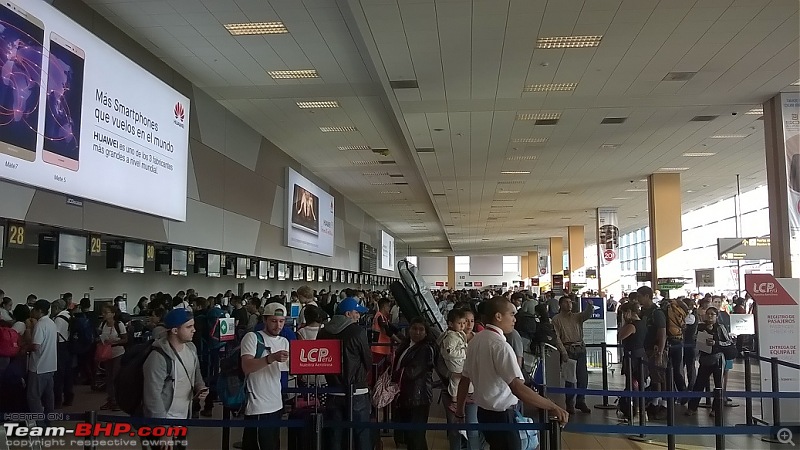 ▲ Image 2: View of the crowded foyer at Lima airport, domestic side  ▲ Image 3: Boarding Pass! If you can try and get a seat on the right side to see some of the Andean cities and two of the higher peaks (Quishuar and Salcantay) as the aircraft completes the 45 minute journey [Like many flight paths the Lima-Cusco route avoids overflying the peaks and tries to follow the few towns along the way in case of an emergency]. Due to the high altitude of the Andes the ground appears close to the window. If the sky is clear a view of some of the volcanic crater lakes are also visible. Also, flight direction being East-South-East, there is no sun glare on the right side on a morning flight. A quick meal is served but like many things in South America the default option is non-vegetarian [smaller carriers offer no choice]. Cusco’s Alejandro Velasco Astete airport is tiny and everybody walks from the parking bay to the terminal - though there are two aerobridges. It is also well located in the city (which lies in a NW-SE valley) and has plenty of parking as well as a local bus station outside for the adventurous. Touts and scamsters are non-existent and there is no security paranoia. This is a good city to stock up on supplies - water, insect repellent, protein bars, medication, walking sticks, hats - all can be found easily at favourable prices. It’s also the last place to change money at competitive rates. Those prone to altitude sickness are recommended a couple of days acclimatization here by the guidebooks though views differ and others suggest that the key to avoiding altitude trouble is to quickly get out of Cusco into Machu Picchu which is a thousand metres lower than Cusco. I stayed in Cusco for the day of my arrival and in any case have no altitude problems. ▼ Images 4-6: Some views from above. Star Peru uses the BAe 146 aircraft - a small (like B 737) aircraft but with four turbines. 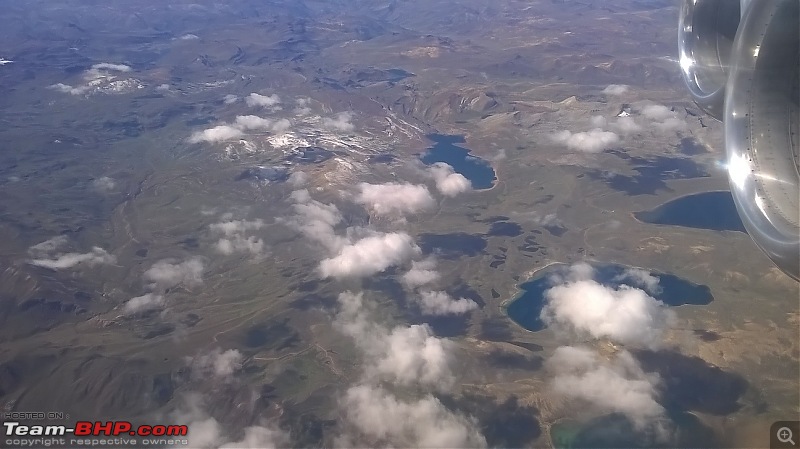 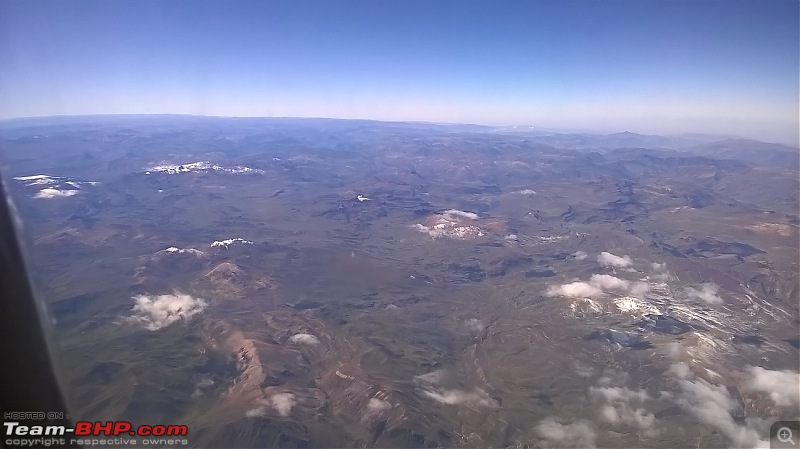  ▼ Image 7: Cusco aerial view  ▼ Image 8: Cusco airport  Last edited by Kumar R : 5th October 2017 at 04:13. |
| |  (24)
Thanks (24)
Thanks
 |
| The following 24 BHPians Thank Kumar R for this useful post: | //M, 14000rpm, ajmat, BlackBeard, Gannu_1, gmhossain, GTO, jaunthead, Klub Class, Lij, Nempuguru, parsh, poised2drive, procrj, pulsar56, Rehaan, samabhi, Samba, SmartCat, sparky@home, sukiwa, vb-saan, YaeJay, yosbert |
| | #3 |
| BHPian Join Date: Apr 2014 Location: Account closed
Posts: 315
Thanked: 1,005 Times
| re: Machu Picchu, Peru - The Lesser Known Route 4. Which Route to Machu Picchu? This is an interesting question. Machu Picchu is situated at the top of a steep hill rising about 600 m (absolute elevation is 2,400m) over the immediate surroundings. At the base of that hill is a tiny touristy town named Aguas Calientes (literally ‘hot waters’) that has developed as a staging point of sorts, where Machu Picchu-bound tourists stop for a break or overnight. With rare exceptions travel to Machu Picchu necessarily involves passing through Aguas Calientes which itself lies about 220 km by road from Cusco in a somewhat north-westerly direction (75 km aerial distance). 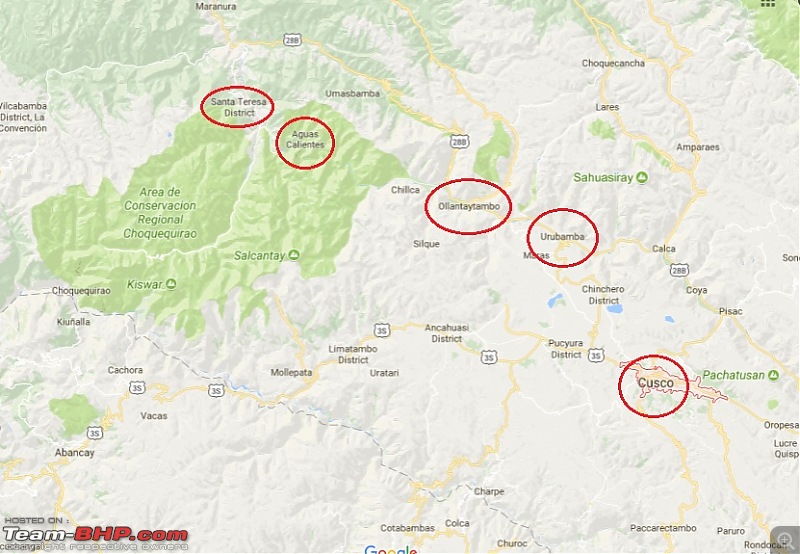 ▲ Image 9: Relative location of Cusco, Aguas Calientes and other relevant places As far as I know three distinct and diverse routes are available. #1 By Rail The most publicised and touristy route is the light rail from Cusco (actually from Poroy, 13 km outside Cusco). It takes about 4 hours, is comfortable and terminates at Aguas Calientes. The cheapest tickets are about USD 70+ return (residents have it significantly cheaper) and a limited luggage allowance is permitted. The operator is Perurail which runs three pairs of services daily though there are two other operators who run a dozen daily services day between AC and the mid-point town of Ollantaytambo (70 km from Cusco). [Ollantaytambo is also the place where the road and rail routes to Aguas Calientes part ways] The trains are reliable, clean, appear professional enough and leave on time. The railway line partners the road from Cusco to Ollantaytambo after which the track goes straight to Aguas Calientes through the jungle by the edge of the Urubamba river while the road climbs into the mountains and heads north. Children, the elderly and anyone with trouble walking, likely to need medical attention or not in average to less-than-average physical fitness should certainly take the train.  ▲ Image 10: Fleeting view of Ollantaytambo railway station, while returning #2 Inca Trail The other route that some know of is the trekking path on the Inca Trail which originates at three-four different places and is about 80+ km (depending on which exact trail is selected). These culminate directly into the Machu Picchu site bypassing Aguas Calientes. Permits are sold out months in advance and guides must be hired through government-recognised agencies. The trail itself is apparently strenuous and a fair degree of commitment and enthusiasm for trekking is needed (not to mention cost and time) to choose this. The cheapest (and shortest) tours are $400+ and last four days. #3 By road and foot I also stumbled on a third option - an alternative not widely known except a few blogs and some fragmented questions on Tripadvisor. There was so little information that even my former Peruvian classmate was unhelpful. The route consists of a bus journey from Cusco on the Cusco-Ollantaytambo-Quillabamba road, followed by two successive hops across tiny villages by share-taxis, finally arriving at a hydroelectric power station on the Urubamba downstream of Aguas Calientes. From there it is a long hike to Aguas Calientes. I chose this because it had an air of adventure, was considerably cheaper (at least if the accounts I read on the internet were to be believed) yet was doable for someone not used or trained for mainstream trekking (in other words, a couch potato). The plan was to spend the first day traveling to Aguas Calientes, the second at Machu Picchu itself with the return to Cusco taking place on the third day. Note - One could well ask why a direct motorable road was not constructed alongside the railway line from Cusco to Aguas Calientes. While engineering problems and environment issues are possible I suspect the Peruvian government has deliberately chosen not to do so in order to milk the railway traffic as much as it can. It also has a side-effect of artificially limiting tourist numbers to Machu Picchu - something the government seems to be pursuing seriously. The last leg is a 3-4 hour hike for 20 km along a railway line and also following the Urubamba river - approaching Aguas Calientes from the side opposite to the railway line that I described as the first option. [The railway line that this hike follows is the same line but that stretch is used only for two trains a day, mostly carrying supplies to the hydroelectric plant that lies at the end of the line]. Last edited by Kumar R : 4th October 2017 at 04:45. |
| |  (23)
Thanks (23)
Thanks
 |
| The following 23 BHPians Thank Kumar R for this useful post: | 14000rpm, agspins, ajmat, BlackBeard, Gannu_1, gmhossain, GTO, jaunthead, Klub Class, libranof1987, Lij, mpksuhas, Nempuguru, parsh, procrj, pulsar56, rajesh1868, Rehaan, Samba, sparky@home, vb-saan, YaeJay, yosbert |
| | #4 |
| BHPian Join Date: Apr 2014 Location: Account closed
Posts: 315
Thanked: 1,005 Times
| re: Machu Picchu, Peru - The Lesser Known Route 5. The Journey Begins: Cusco to Santa Maria My narration can be understood with the map following this para. The immediate destination from Cusco is a tiny village named Santa Maria, about 190 km away that lies on a mountain road connecting Cusco to several provincial towns. Santa Maria is otherwise insignificant and a traveler has to board a bus to Quillabamba, the only destination on that route. ▼ Image 11: Cusco to Santa Maria  My very generous Airbnb host in Cusco had warned me that the total travel time to Aguas Calientes by this route would be about 10 hours and buses while not uncommon were not bountiful either; reluctant to find myself on what might well be a lonely trail after dark I resolved to start as early as possible and reached the bus terminal at 0630, a short minivan ride away from my accommodation. Except as I found out - this terminal – named Terminal Terrestre (a common name for South American main bus terminals) serviced only ‘good’ buses run by operators having a certain degree of sophistication and seemed designed for non-local travellers travelling to or from far regions of south-central Peru and Bolivia. My ‘local’ bus to Quillabamba was not among them. This was a grave planning blunder I made, relying on Google. To my horror none of the employees of the various operators manning the counters could speak even rudimentary English so as to give me directions to the correct terminal / bus station. They were also not able to understand the map of Cusco on my GPS app (downloaded the previous day - I otherwise had no mobile service). At 0715 after fifteen exasperating minutes spent in mimes and skits in an effort to communicate I decided to walk to the ‘historic’ centre of the city (another distinctive feature of S. American cities), trying my luck with strangers along the way. Fortunately, like us, South Americans are a warm and friendly people and many cheerfully took time off to listen to my question. The language barrier was significant but finally I received guidance that buses to Quillabamba left from the unsurprisingly named Terminal Quillabamba - about 3 km away. There was no point saving pennies by walking such a distance and I reluctantly negotiated a S/10 ($3) taxi which took 7-8 minutes and dropped me off at the bus station at about 0730. ▼ Image 12: Location of Terminal Quillabamba, Cusco  Unlike the larger Terminal Terrestre, this bus station was quite small, not much more than a walled yard, little larger than the Electric House bus station compound in Bombay. It had three-four stalls each owned by distinct operators selling tickets for the few destinations serviced - all along the road to Quillabamba. A couple of fast food shops, fruit carts and garment sellers completed the picture. My host had recommended Turismo Ampay (one such operator) and I saw a vehicle with that emblem parked within, along with another from Transportes Selva Sur (a competitor). Neither looked particularly better than the other though Ampay charged S/25 ($7.5) compared to Selva Sur’s S/20 ($6). The buses were medium range with a large cargo space to hold livestock feed and many cages of juvenile lambs, hens and hamsters at the rear cargo compartment. In India they might be classified as ‘good’ but Peru is a prosperous country (per capita is four times that of India) and these buses were very basic. Officially no standing was allowed but within an hour of leaving plenty of short distance passengers were taken who had no choice except to stand. I was among the last to board and managed only an aisle seat besides an old native (Quechua) Peruvian lady. Luggage rack space was precious and filled with all manner of vegetables, fruit and live hamsters in cages.  ▲ Image 13: My bus. Like much of South America, catholic motifs are quite common.  ▲ Image 14: Interiors. The people are comparable to us in stature so leg room was a pinch My bus service (Ampay) was scheduled to leave at 0830 and the one by Selva Sur at 0845. I was told there were three more buses that day at 0930, 1030 and 1130. None of those would have been suitable for my purposes as later events were to prove. An ‘entry tax’ of S/5 ($1.75) was charged to cross the turnstile into the compound and the public lavatory was another S/5. I had read frightening stories of theft on these long distance buses and so temporarily disembarked with my 6kg backpack though at the cost of not finding any overhead room on my return - or indeed, my seat for that matter. Scheduled for 0830 the bus started after much delay at 0850 (another point of similarity with India). The first stop, loo break (and also animal feeding break) was at Urubamba, 50 km away. This tiny town is at the end of the Cusco valley and marked the start of hilly terrain. It was also a place to pick up some pineapple slices and gigantic corn kernel from vendors. Shortly thereafter at 1035 came Ollantaytambo - the second stop. I did not see any international tourists get up here (or at Cusco for that matter) though there was a local family who were headed to Huoyro - a local minor tourist attraction on the way. Apart from being the point of divergence with the light rail line, Ollantaytambo is also where the Urubamba river leaves the road; it would later rejoin my path at Santa Maria, having channeled and meandered past Aguas Calientes. The remaining 110 km took three hours; entering the Malaga pass (4300m) our road was very steep, narrow and full of bends (though in good condition) with the bus stopping twice due to dense fog. The air was cold and a medium jacket necessary. Two more stops were made along the way - Abra Malaga and Huoyro. The old lady by the window was asleep throughout but she was sporting enough to let me extend my long arm out of the window for some photos - in exchange for using my shoulder as a headrest. There were no announcements throughout the journey and I had to go up forward to remind the (very sleepy) conductor several times to warn me of my stop. I finally reached Santa Maria a little after 1330 - almost five hours.  ▲ Image 15: Illustration of the dense fog that made progress impossible   ▲ Images 16-17: Views from the bus-journey  ▲ Image 18: Arrival at Santa Maria Last edited by Kumar R : 4th October 2017 at 05:04. |
| |  (22)
Thanks (22)
Thanks
 |
| The following 22 BHPians Thank Kumar R for this useful post: | 14000rpm, agspins, BlackBeard, Gannu_1, gmhossain, GTO, jaunthead, Klub Class, Lij, luvDriving, mpksuhas, Nempuguru, parsh, pulsar56, Rehaan, Samba, SilverSmoke, SmartCat, sparky@home, sukiwa, vb-saan, yosbert |
| | #5 |
| BHPian Join Date: Apr 2014 Location: Account closed
Posts: 315
Thanked: 1,005 Times
| re: Machu Picchu, Peru - The Lesser Known Route 6. On collectivos: Santa Maria to Hydroelectrico Santa Maria was little more than a glorified bus stop with a row of low buildings running 300 yards one side of the road. The ‘town’ had one general purpose provision store and two small cafes / restaurants; not having eaten anything since morning I went straight to the larger establishment. The place was spacious and the décor minimal - clones of the neelkamal plastic chairs we see at roadside dhabas here. Not being a particularly touristy place my entry (together with my non-white yet alien looks) aroused some curiosity and I was reminded of cliched scenes in Hollywood westerns where the piano and conversation halt when a stranger enters the saloon. There was only one meal with a choice of chicken (pollo) and pork (cerdo). I am not averse to pork but since I did not know what part of that animal would be served I chose the former. Like all south american meals there was a bowl of soupy broth (which on draining had two chicken feet) followed by a generous serving of rice, boiled carrots, cauliflower, casava (a distant cousin of the potato) and the leg of some species of enormous chicken. Accompaniments were a slice of dangerously hot capsicum and lemon. The owner insisted on adding more chicken when I finished my portion, no doubt impressed by my ability to tolerate the chilli. The whole meal was washed down by some coco-leaf tea - a national pastime in that part of the world. The cost - a mere S/7 (with S/2 for the tea). While I was eating two of the old-timers came over to chat and upon finishing they were more than willing to pose for a photograph.  ▲ Image 19: Lunch at Santa Maria 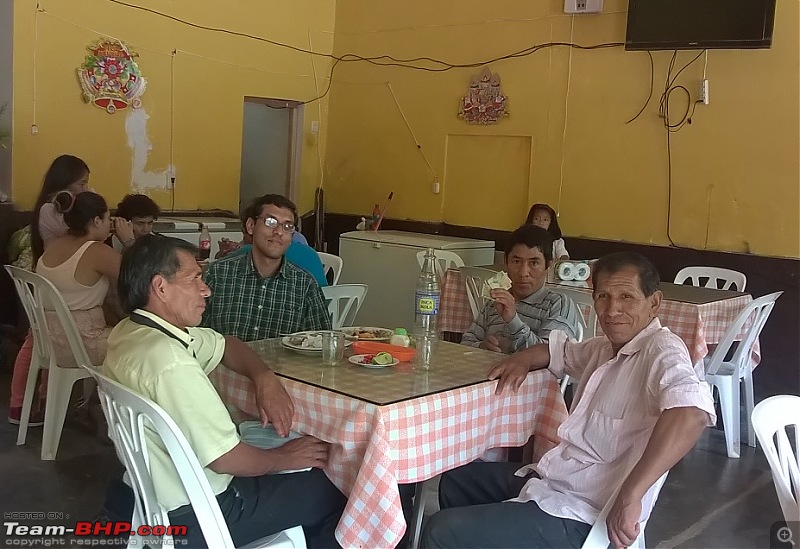 ▲ Image 20: The local clientele with yours truly Lunch over I walked to the general store where the owner, despite being woken up from his siesta not only gave me detailed instructions on my journey but also very kindly exchanged $100 to S/300 - a loss of about S/20 for me - but necessary as I was worried about conversion later on. He also gave me the timings when the return bus would halt - in case I intended to avail of that later. Outside his shop was a small parking area where 4-5 assorted cars stood waiting to take people on a sharing basis to Santa Teresa - another town 24 km away. The journey on these share-taxis (named collectivos) would cost me S/15 ($4.50) but I had to spend 35 minutes waiting for my vehicle to get filled - another lesson in local public transport. In the meantime I occupied myself by devouring three very large bananas that I bought off an urchin at S/1 apiece. Luckily I had the front seat beside the driver - with the promise of the best view of the road - and a earful of the catchy Spanish songs that he played throughout. We finally started at 1430 after a spanish couple took the two rear seats.  ▲ Image 21: The provision store (also doubles up as a bus ticket agency) ▼ Image 22: Map showing Santa Maria to Santa Teresa route 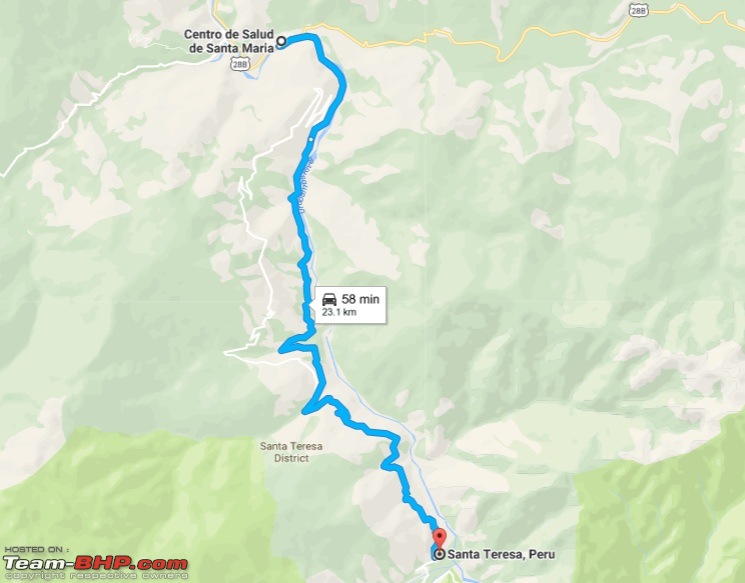 My immediate destination was the small town of Santa Teresa, 24km away. This was an hour long drive along the edges of a mountain range that bordered the Urubamba as it flowed in a deep valley beside us. Unlike the morning when my path was in the same direction as the river, this time it was against the direction of flow. The road, coming perpendicularly off the Cusco-Quillabamba highway was a rocky, dirt track one lane wide full of hairpin bends and steep edges. I later learnt that the sides of these mountains were very prone to landslides and that explained the lack of vegetation cover and a huge amount of particulate debris that any passing vehicle stirred up into a dust cloud obscuring vision. The driver, Jorge, was in his late 40s, very experienced and drove like a maniac in his Toyota for most of the way except when we had to stop to let an incoming vehicle pass. The ride was intensely bumpy and photography was hard. I counted a dozen vehicles passing us, some of which were small jeeps returning from supplying the hydroelectrico while a few others were collectivos ferrying passengers back to Santa Maria and the highway. We got into Santa Teresa slightly before 1520, and were dropped off at a newly constructed tourist shelter that was not in operation. Below there were three-four collectivos waiting to fill up for the return journey. Santa Teresa is a growing village that attracts backpackers not only due to its proximity with Machu Picchu but also for its natural hot water springs (perhaps the origin of the name Aguas Calientes). The village (or town) is clean, has few people and a few shops. Housing a solitary first-aid clinic and dispensary, this was effectively the last place to seek basic medical treatment. I would now have to find someone willing to take me upto the hydroelectrico another 10km away - clearly that was not a lucrative route. Very luckily I found a collectivo who had been instructed to pick up some people at the hydroelectrico that evening and was not averse to making a few extra Soles (S/10) by giving me a lift. His vehicle, a newish Suzuki, was more comfortable but the road quickly deteriorated into a mix of pebbles, sand and mud that inspired very little confidence. A 20 minute bone jarring ride later I was at the hydroelectrico where the road came to an end. ▼ Image 23: Arrival at Santa Teresa  Note: The ability to drive right upto the hydroelectrico is recent, owing to a light motorable bridge constructed in the past few years. I heard that a few months ago heavy flooding and rains on the Urubamba river washed away parts of this bridge - meaning it may not be possible to cross here very easily except with a zip line. ▼ Images 24-26: Views from the Santa Maria -- Hydroelectrico drive   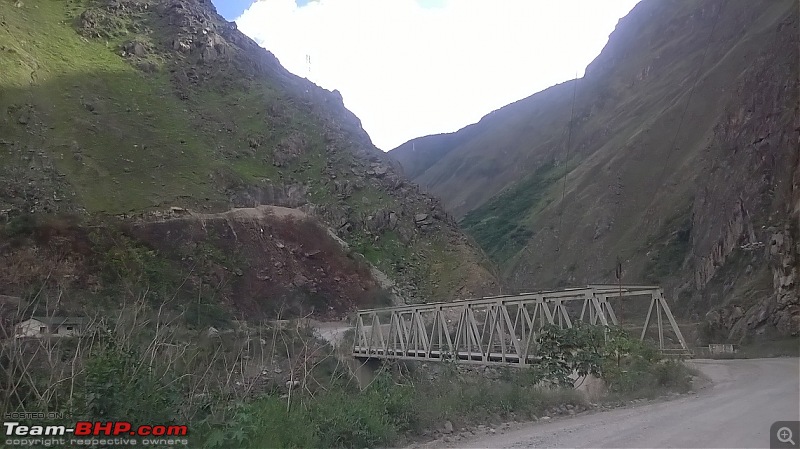 ▼ Images 27-28: Arrival at the Hydroelectrico  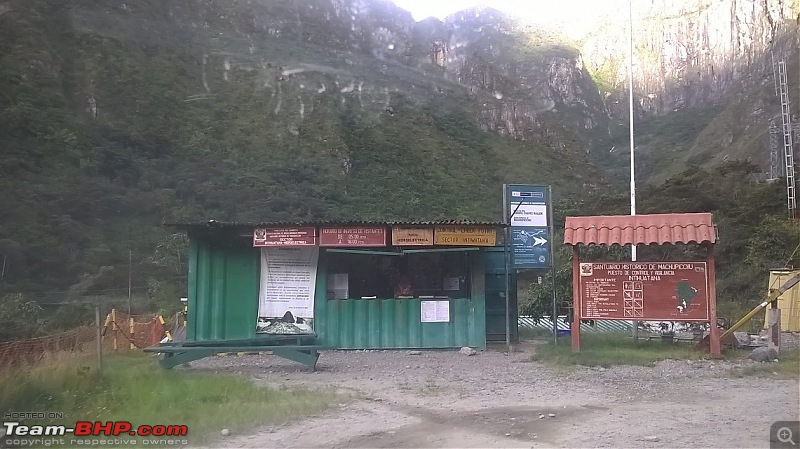 ▼ Image 29: Map showing Santa Teresa to Hydroelectrico route  Last edited by Kumar R : 4th October 2017 at 14:00. |
| |  (21)
Thanks (21)
Thanks
 |
| The following 21 BHPians Thank Kumar R for this useful post: | 14000rpm, akbaree, Baddychat, BlackBeard, Gannu_1, gmhossain, GTO, isandy, jaunthead, Klub Class, libranof1987, Lij, mpksuhas, Nempuguru, parsh, pulsar56, Rehaan, Samba, SmartCat, vb-saan, yosbert |
| | #6 |
| BHPian Join Date: Apr 2014 Location: Account closed
Posts: 315
Thanked: 1,005 Times
| re: Machu Picchu, Peru - The Lesser Known Route 7. The hike to Aguas Calientes Before I describe this part of the journey it is helpful to have an idea of the terrain. Machu Picchu appears to be built on a steep mountain flattened at the top. In reality the flat top is bordered on one side by an even higher, equally steep mountain named Machu Picchu montana (or mountain). This is rarely seen in the ‘classic’ Machu Picchu photos because it looms behind the photographer. This composite mountain, together with the well-known sharp mountain in the classic Machu Picchu background form an elevated feature, circular in cross section at the base around which the Urubamba flows in an anti-clockwise direction from right to left forming a deep gorge through which my path lay. ▼ Image 30: Map showing Hydroelectrico - Aguas Calientes route  The red line represents the direction of my hike, generally within 5 to 50 feet of the Urubamba river - for a total of 20 km till the centre of Aguas Calientes. There is no real path or road but there is the continuation of the single track railway line which began at Cusco and ran till Aguas Calientes (black line). Beyond AC the track follows the river and terminates at the Hydroelectrico. While it is possible technically for the train to run till the latter, most do not and none of the advertised services formally have the hydroelectrico as a commercial halt. As far as I know only one train actually travels that distance returning at 1600 - it is not intended as a commercial service and only locals who work at the power station or vendors and suppliers, along with cargo and supplies are ferried; nonetheless I have heard anecdotal stories of being able to purchase a ticket from the hydroelectrico till AC for about S/25 ($7.75). The terrain can be further understood by this crude cross section, viewed from the hydroelectrico. ▼ Image 31: Map showing the terrain on Hydroelectrico - Aguas Calientes route  The Hydroelectrico itself has activity in the form of some fruit sellers, dhabas and urchins who service the employees and suppliers of not only the Hydroelectrico but also the railway crew and a few government offices. There are also two-three small motels that have come up to cater to the tourist traffic since some - especially those who reach late - prefer to spend the night here instead of hiking in the dark. The peak of the activity is when the 1600 daily train departs. I had arrived at 1530 and was just in time to observe this surge. ▼ Images 32-34: At the Hydroelectrico and with the 1600 train    The path itself is sometimes narrow, other places broad - depending on the riverbank and the steepness of the valley. The river varies from a wide placid lake-like flow to a rapid and has both gentle reed-filled banks with large polished pebbles to shallow gorges carved in black granite. At the narrowest the path is simply the single railway track, with a gauge of 1,435mm (our IR broad gauge is 1,676mm). The line is, of course, non-electrified and has a dozen bridges ranging from a large rusted iron truss bridge 2km after the Hydroelectrico to smaller concrete bridges over minor water channels (I have a frightening video of walking across this groaning rusty bridge). As I was walking in a clockwise direction the river was to my right and the dense vegetation to my left, with the wall of the valley rising thereafter. ▼ Images 35-38: Photos of the hike to Aguas Calientes     Except for a slight ascent at the start no climbing was needed. However the walking was not easy; more than half of the way required walking on the tracks or the crushed granite ballast; my toenails were soon hurt - later I lost two. At some places the ballast was not settled and it was slippery. The large bridge at the start was a bit worrying as it was highly rusted and the footplates loose - I was debating whether a fall would cause me to drown or break my neck on the rocks. The late afternoon heat was very humid and my shirt was soaked through for much of the time. Sandflies were everywhere - it was January, summer in Peru, and these pests were attracted whenever I strayed too close to the vegetation. Sandfly bites are not painful while they feed but become a very itchy rash afterwards; the problem is compounded if they are unknowingly squashed while feeding - the biting part remains in the skin and causes a small blister that took (in my case) two weeks to heal. I had forgotten to take insecticide since I was travelling without check-in luggage and it skipped my mind in Cusco. I encountered very few travelers - there were about two dozen who crossed me, almost all returning from the Inca trail with trekking equipment and guides - most of whom waved or exchanged a word of encouragement. Three very hardy german women overtook me at some point though I caught up with them later. An argentine couple was in distress because the husband’s feet were in tatters - he had foolishly worn sandals. As much as I wanted to help there was little I could do beyond provide company - they were likely to return and had each other; I, on the other hand, was alone and had no desire to be stranded. [as it happens I met them in Aguas Calientes the next day] I also counted three-four railway employees at various points along the way and a few Peruvian women with makeshift stands selling pineapple and oranges. ▼ Images 39-42: Photos of the hike to Aguas Calientes (continued)     On the bright side the hike was serene, adventurous and visually beautiful. Simply following the river was enough to distract me for minutes while looking out for the many exotic bird calls made it seem like a safari. At certain places I heard activity in the foliage to my left and my imagination ran wild picturing all manner of beast from the capybara to the jaguar. There were many species of understory palms, especially the spiny Aiphanes species - though the climate was too humid for the Ceroxylon that I hoped to see in habitat (highest-altitude palms). This walk is a distance of about 18km from the start of the Hydroelectrico to Aguas Calientes. Some guides mention 14km but that excludes a lot, especially if you have trouble doing the initial bit of scrambling up from the Hydroelectrico and have to follow the meandering railway line. There are distance markers graded in km along the way though not uniformly. Given the unsteady nature of the trail and the high likelihood of an ankle-twist a good pair of hiking boots with ankle protection was a must-have; equally important was a pair of heavy trekking wool socks, mostly to cushion the toenails and draw out excess sweat (despite this I still lost two nails). The railway line was used for only one service at that time (the 1600 from the Hydroelectrico) I did notice some shunting as I neared Aguas Calientes - to that extent a degree of caution was necessary. A similar bit of foresight was needed navigating the three short tunnels along the way - filled with water puddles, leaking ceilings and bats. ▼ Images 43-45: Photos of the hike to Aguas Calientes (continued) - Reaching Aguas Calientes  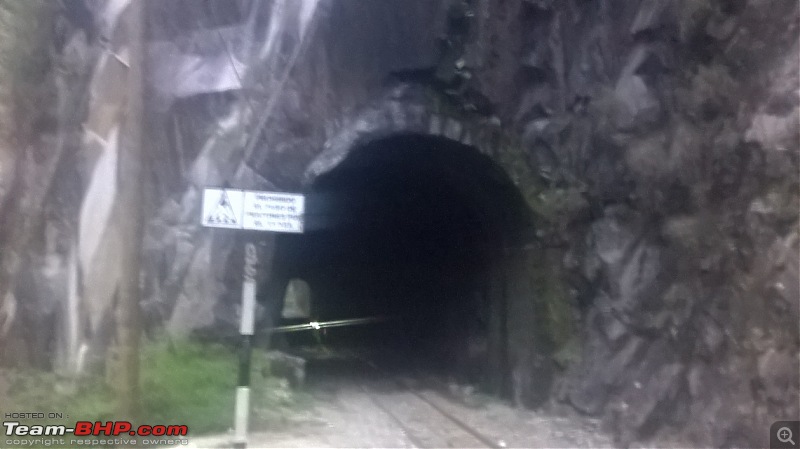  My GPS was about the only reassurance I had on this hike and it was often infuriating to see how little my position changed in real terms even after 20 minutes of hard walking due to the circuitous nature of the trail. Aguas Calientes is about as far south of the equator as Chennai is north and, as such, evening falls at a standard time despite being at the peak of summer. The trail and railway line no longer kept pace with the Riobamba but instead climbed somewhat with the river visible in a small gorge on the side. By 1820 it was twilight and after crossing one final railway tunnel in near darkness I spotted the lights of Aguas Calientes, making my way into the main square by 1900. The place was expectedly filled with tourists, restaurants, pubs, souvenir shops and money-changers - all charging almost double the standard rates. There were plenty of tourist police and at no point did I feel unsafe. Again no touts, scamsters or hustlers - overall a very pleasant ambience. The town sits at the junction of the railway line and the road to Macchu Pichhu and is bisected by the Urubamba river The most important thing, however, was to buy my (expensive) entry ticket (S/152 or $46) and this I did at the tourism office which remains open till 2100 - a big convenience for tourists. This done I located and checked into my hostel and after a somewhat inadequate dinner of biscuits and nuts (I was too tired to venture out again) relaxed in my bunk bed. ▼ Image 46: Aguas Calientes central plaza  ▼ Image 47: Machu Picchu Ticketing Office  ▼ Image 48: My Hostel  Note: Tickets can be purchased also at Lima or Cusco from the Tourism office, or even online. I was tracking the availability online (limited quantity per day) and judging from the trend chose to buy it at Aguas Calientes itself. The official site is http://www.machupicchu.gob.pe/ ▼ Image 49: GPS plotting of my journey from Cusco to Agaus Calientes  Last edited by Kumar R : 5th October 2017 at 07:18. |
| |  (19)
Thanks (19)
Thanks
 |
| The following 19 BHPians Thank Kumar R for this useful post: | 14000rpm, agspins, BlackBeard, Gannu_1, gmhossain, GTO, jaunthead, Klub Class, libranof1987, Lij, mpksuhas, Nempuguru, parsh, pulsar56, Rehaan, Samba, SmartCat, vb-saan, yosbert |
| | #7 |
| BHPian Join Date: Apr 2014 Location: Account closed
Posts: 315
Thanked: 1,005 Times
| re: Machu Picchu, Peru - The Lesser Known Route 8. Machu Picchu !!! The morning of Jan 5th began inauspiciously - instead of an early start before daylight I awoke late with stiff limbs at about 0800, fatigued by the exertion of the previous day; in place of a bright sunny day it was drizzling with light fog. After a relatively late (and heavy) breakfast I started at 0915 and in a few minutes reached the road leading towards Macchu Picchu, saddened at the idea that the view from the top might be obscured - a common let down for tourists in the Nov-Jan rainy season. From here Machu Picchu is approximately 600m high and can be accessed by either a 20 minute bus ride or a two hour climb up the ancient Inca carved steps along the edge of the mountain. The bus costs about $15 for a return ticket, leaves every 10 minutes and is the preferred mode of ascent and descent for 90% of the tourists visiting Machu Picchu. I chose to hike. ▼ Image 50: Aguas Calientes city centre in daylight. The town is bisected by the Urubamba  ▼ Image 51: Minibuses waiting to fill up before leaving for Machu Picchu. At peak hours they can be booked out in advance.  The entrance trail from Aguas Calientes consists of a backtrack for about 2 km somewhat in the same direction as the trail from the Hydroelectrico I had hiked yesterday but at a much lower elevation. It reaches a manned checkpost next to a sturdy shallow bridge. This is where the unofficial entry to the site is - unofficial because technically the ticket is not required till entrance to the ruins at the every top - nonetheless a guard inspected mine very carefully. Past the guard I walked over the bridge and reached a small T junction - the motorable road to the top begins on the left whereas the hiking trail starts on the right. ▼ Images 52-53: The start of the trail from Aguas Calientes to Machu Picchu - visible on the right edge. At this point the path is broad enough to accommodate minibuses   ▼ Image 54: Guard checkpost before crossing the Urubamba one final time 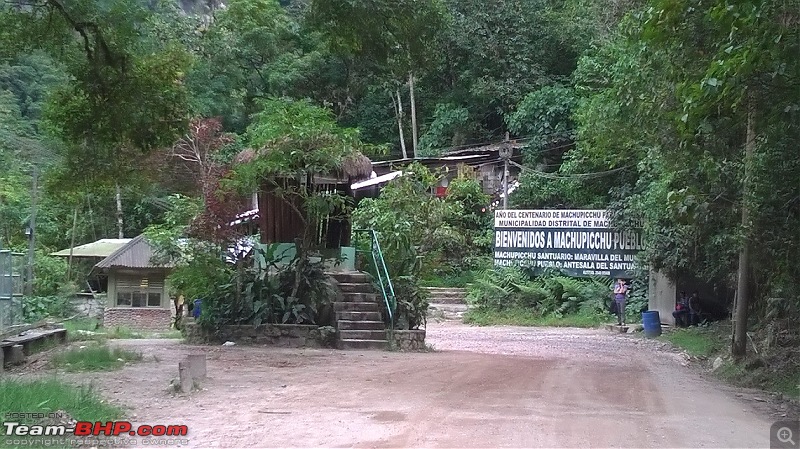 ▼ Image 55: Suspension bridge after the checkpost. The motorable path to the top is to the left, the hiking trail is to the right.  ▼ Image 56: Trail map 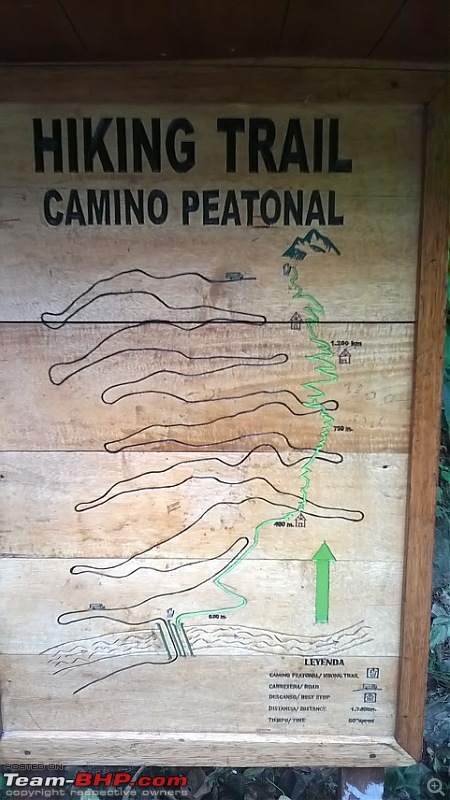 My research had indicated it would take less than two hours to make the 600 metre ascent upto the ruins - a distance of about 2 km. The hiking trail went straight up the side of the mountain cutting across the zig-zag motorable road at a dozen places. Most of this path consisted of carved stone steps apparently used by the Incas as the main mode of entry / exit (though there is a dangerous bank entrance to the ruins as well). There was no pattern to the steps and there were often some easy stretches followed by steep scrambles. Within a few minutes of starting my climb I came across a few other climbers and we soon made a strange assorted group - a Columbian (Vivianna), a Venezuelan (Carmenza), a Mexican (Santiago) and myself. This made the tiring climb very tolerable and we had plenty of chit chat and many rest breaks as we made our way to the top stopping often for photographs and to admire the view - very hard from the bus. Plenty of exotic orchids, tree ferns and razor sharp reeds grew along the hillside and made for interesting sights. The rain eventually stopped and the weather was humid and hot and the steps slippery with moss at many places. We passed a few tourists on their way down, often stopping them to ask how much more there was. We finally reached the ruins at 1145 - a 90 minute climb with a tiny backpack consisting of a 600mn water bottle, a sandwich, a can of juice and two bars of chocolate along with spare spectacles, medicine, a towel and my passport. One mistake I made was not carrying a hiking stick. At the top it had started to rain again and all the staff were dressed in waterproof ponchos or Indiana-Jones style hats. ▼ Image 57: My climbing party. The company was immensely enjoyable.  ▼ Image 58: The start of the trail 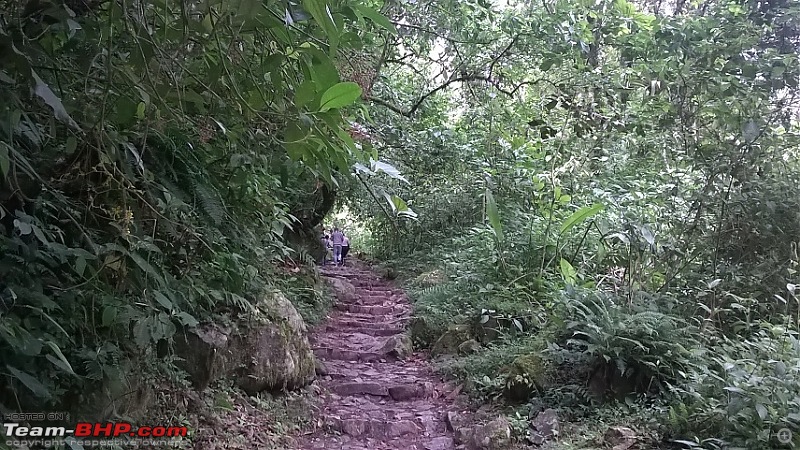 ▼ Image 59: The trail would often intersect the road at some places along the way  ▼ Images 60-63: Photos from the ascent trail     Standing in line for the ticket inspection at the entrance gate it was easy to see just how much of an attraction Macchu Picchu is. Hundreds of tourists from Europe, South America and the USA were here at great cost and some degree of difficulty to see the ‘lost city’ of the Incas. Everyone was excited and the fog, rain and chilly breeze did nothing to reduce the mood. Our party increased while waiting in line as we met a couple from Peru and another lady from Columbia - together we also decided to split costs for a guide - a must in hindsight. Our tickets were checked briskly and we walked past a turnstile into a staging area where tourists and guides haggled over prices and routes. The staging are is also the last opportunity to buy water or use the restroom - neither is available inside the ruins. The staff provide a guide map that is complex and difficult to understand - it also highlights one feature of Macchu Picchu - the requirement of following certain predefined routes while seeing the ruins. This is another reason why a guide is important - they can describe the pros and cons of the options. ▼ Images 64-65: Reaching the entrance   ▼ Image 66: Plaque commemorating the 'discovery' of Machu Picchu by Hiram Bingham. There is an ongoing dispute between Peru and Yale University which houses thousands of artifacts taken away by Bingham  ▼ Image 67: Our very jovial guide, almost like a character from Tintin 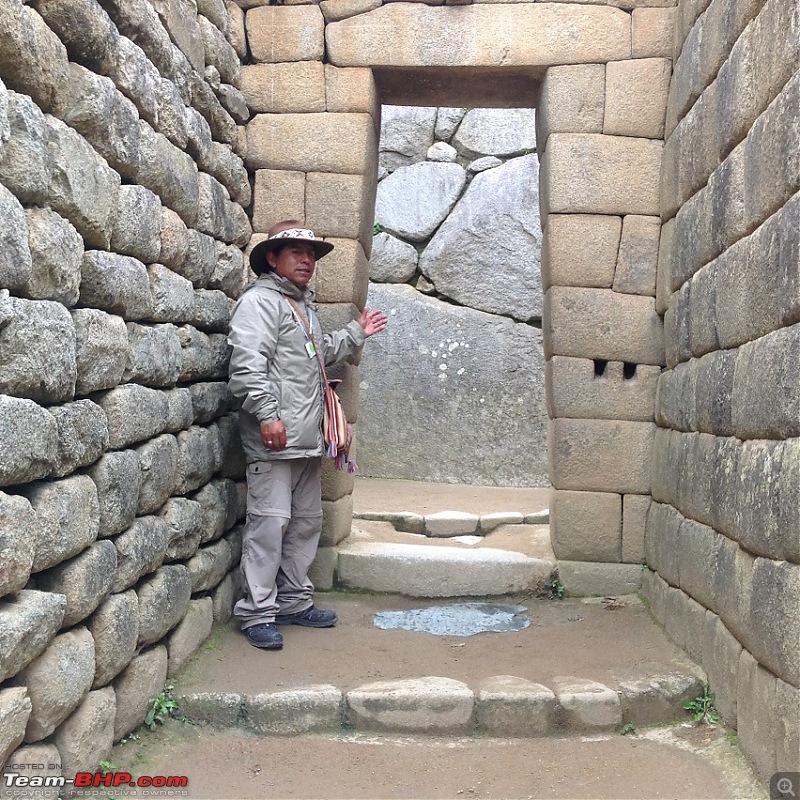 The entry into the main ruins requires a walk along a narrow (but fenced) pathway along the mountainside. Once in the scale of the premises is evident - built on top of this remote mountain is a well planned series of temples, palaces, huts and other structures - even an open-air amphitheatre with planned acoustics - all constructed with fitting stones without the use of cement or mortar. Along the edges of the ruins were open spaces where crops were cultivated - these were now filled by grazing llamas and alpacas. Many of the temples and altars were constructed to align with celestial bodies and shadows - and more than once it felt like something from an Indiana Jones movie. I cannot comment more on the various structures but everything is meaningfully laid out and our guide did an excellent job of explaining the history. The entire place is over 20 acres and there are many km of staircases totaling thousands of steps- big and small. There is no shade and sunglasses are a good idea. Our guide disengaged at 1500 and we wandered around for an hour before making it to the preferred end-point - a series of small flat plazas just above the ticketing office looking onwards towards the classic Machu Picchu vista. By then most tourists had left and the scene was ripe for taking photographs with the sun at out backs. Luckily the fog had remained away for most of this time so we had good views. ▼ Image 68: The first sight of the ruins - apparently these were the LIG housing   ▼ Image 69: A general panorama of the site. In the background is Huaynu Picchu (also climbable but more steep) 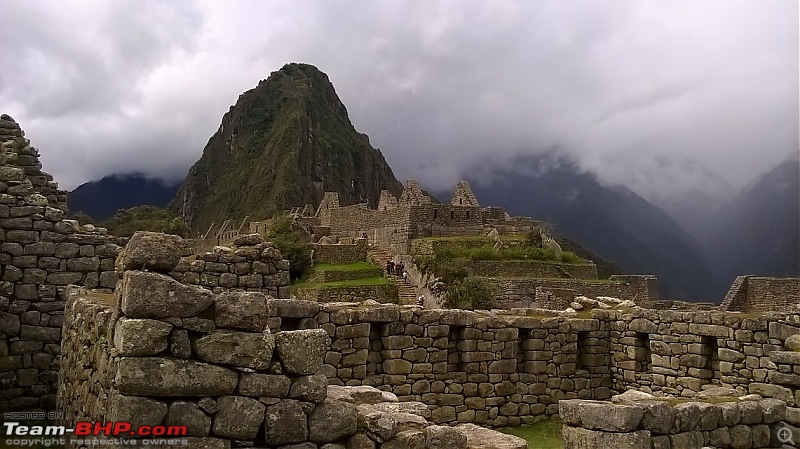 ▼ Image 70: Another vista showing the terraced levels  ▼ Image 71: The distinctive cement-less construction with closely fitting stone blocks  ▼ Image 72: Casa del Inka or House of the Inca (clearly the HIG construction)  ▼ Image 73: One of the few fountains using the ancient piping. I had no qualms in drinking the untreated but pristine water after all that climbing  ▼ Image 74: Temple of the Sun  ▼ Image 75: Reflecting pools used to observe the sky  ▼ Image 76: A sacrificial altar carved from a large stone  ▼ Image 77: The altar of the Condor - also carved from a large stone and made to look like a Condor's head.  ▼ Image 78: Some kind of central plaza, at the highest elevation within the site, clearly for VIPs 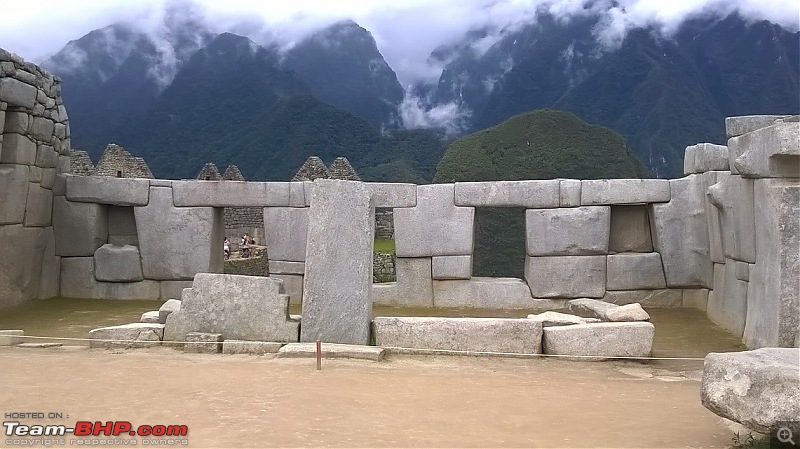 Last edited by Kumar R : 5th October 2017 at 06:26. |
| |  (23)
Thanks (23)
Thanks
 |
| The following 23 BHPians Thank Kumar R for this useful post: | //M, 14000rpm, Arun.K, BlackBeard, Gannu_1, gmhossain, govigov, GTO, hemanth.anand, IcarusMan, jaunthead, Klub Class, libranof1987, Nempuguru, Nonstop-driver, parsh, pulsar56, rajesh1868, Rehaan, Samba, sukiwa, vb-saan, yosbert |
| | #8 |
| BHPian Join Date: Apr 2014 Location: Account closed
Posts: 315
Thanked: 1,005 Times
| re: Machu Picchu, Peru - The Lesser Known Route ▼ Image 79: Another vista of the vertical elevation change within the site. These were supposedly used for cultivation  ▼ Image 80: Posing with a llama. Their wool, like alpaca is quite rough. 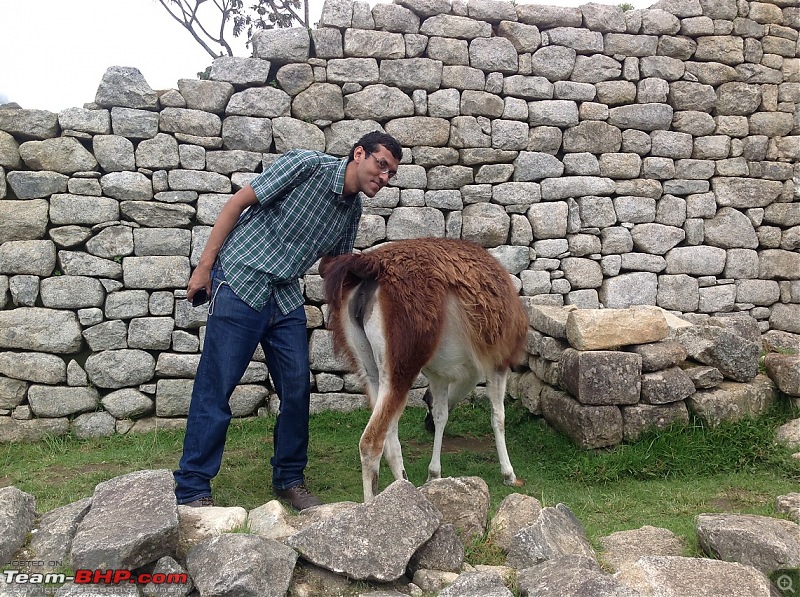 ▼ Image 81: A view of the Urubamba gorge as it meanders its way around the mountain - I had crossed the bridge distantly visible at the bottom while hiking from the Hydroelectrico to Aguas Calientes 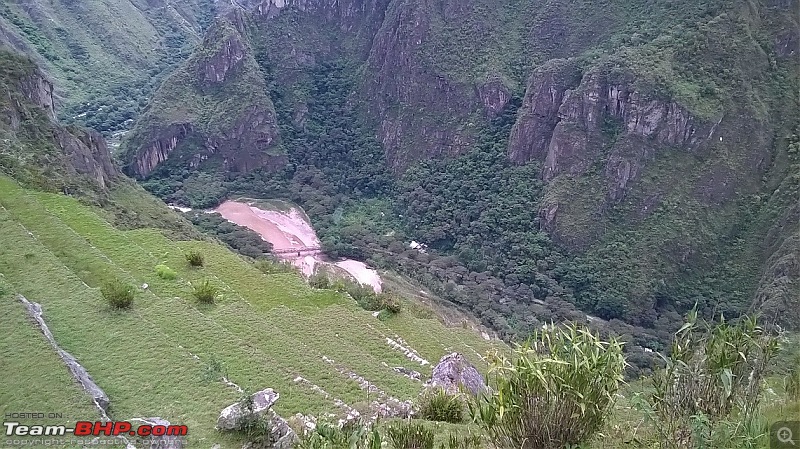 ▼ Images 82-84: Some of the endless stairways. Climbing up is strenuous and climbing down results in plenty of knee bruising  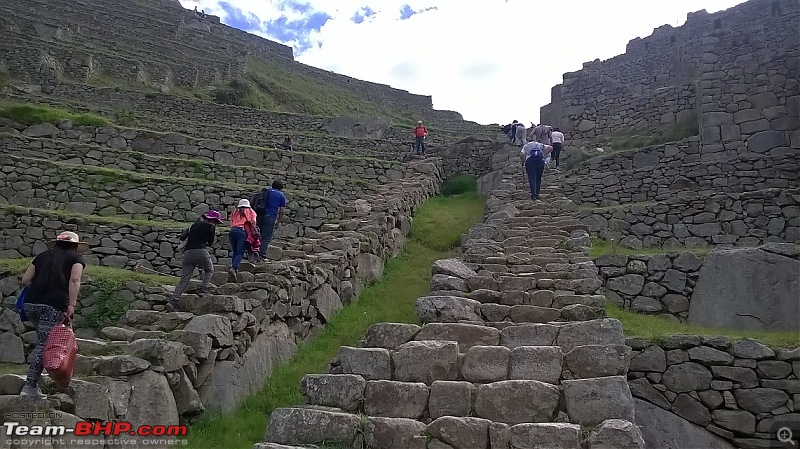  ▼ Image 85: Apart from archaeology there's some interesting wildlife as well like this spider inside a colourful bromeliad  ▼ Image 86: Long shadows signify the end of the day as the site becomes desolate  While Machu Picchu is safe from a law and order perspective and fleecing, scams and harassment is non-existent (by Indian standards) there are other hardships - mostly the remoteness of the location in case of medical emergencies. Our guide informed us that two months prior a pair of tourists had suffered serious injury while climbing and every few months someone seems to die from a fall. The site itself is not fenced except at a few places and it is possible to miscalculate the steepness of the terraced steps at the edge. The closest centre for medical treatment beyond first-aid is effectively Cusco - requiring a 4-5 hour evacuation by road and rail. |
| |  (28)
Thanks (28)
Thanks
 |
| The following 28 BHPians Thank Kumar R for this useful post: | //M, 14000rpm, BlackBeard, Gannu_1, gmhossain, grkonweb, GTO, hemanth.anand, jaunthead, Klub Class, libranof1987, Lij, luvDriving, Nempuguru, Nonstop-driver, novice_alto, parsh, pulsar56, rajesh1868, Rehaan, saargoga, Samba, SmartCat, sparky@home, sri_tesla, sukiwa, vb-saan, yosbert |
| | #9 |
| BHPian Join Date: Apr 2014 Location: Account closed
Posts: 315
Thanked: 1,005 Times
| re: Machu Picchu, Peru - The Lesser Known Route 9. Returning to Aguas Calientes and Cusco We started on the downhill trek at 1700 - almost at the park closure time. Most tourists had left by then and there were about six-seven buses waiting to fill up with the remnants. Half our group chose to take the bus down as they were leaving by the evening train; the rest of us were staying overnight and in no hurry. Before leaving the gate I made sure to collect the Machu Picchu souvenir stamp on my passport (just behind the turnstile) and thereafter wrap it securely in two plastic sleeves for waterproofing (more rain). ▼ Image 80: The Machu Picchu passport souvenir stamp  Walking down was horribly painful - my knees were inflamed and at places I had to almost crawl. After half the descent we switched to the motorable route to avoid the steps which were a lot steeper down than going up. This allowed me a gentler but more time-consuming descent, with the chance to drink clear water from the dozens of tiny mountain streams flowing along the hillside. The main drawbacks were the clouds of dust that each passing bus threw up as well as the relentless sandflies and mosquitoes, no doubt, spurred on by the lengthening shadows and the drop in temperatures. Finally at 1845 we reached the lights of Aguas Calientes; I was starving and we feasted at the Mercado Central (central market) - a food court of local fare with ridiculously low prices (in comparison with the touristy restaurants around). We had french fries, rice, beef, chicken and avocado along with a drink of lemon juice - all for the princely sum of S/10 per head. At almost 2100 we parted ways and I dragged myself back to my hostel for a well-deserved rest. ▼ Images 81-82: Photos of the downhill hike 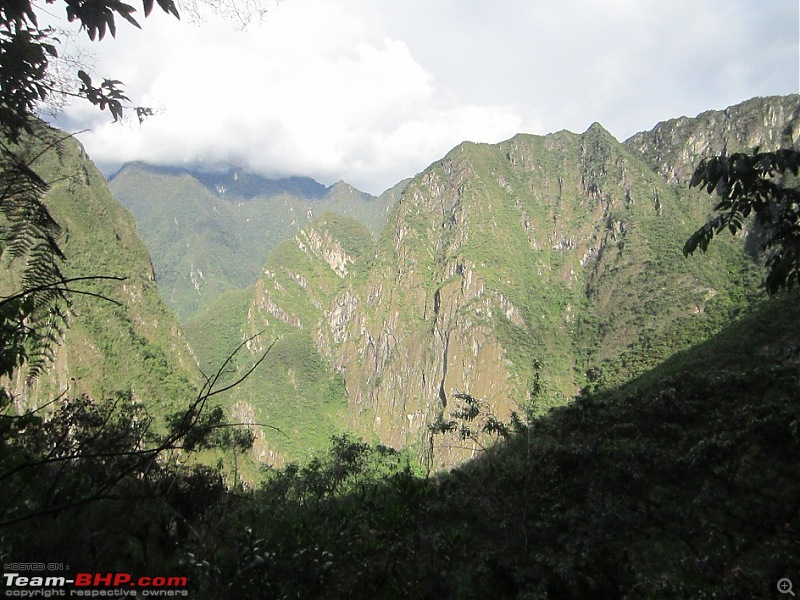  ▼ Image 83: The welcome site of the Mercado Central at Aguas Calientes! 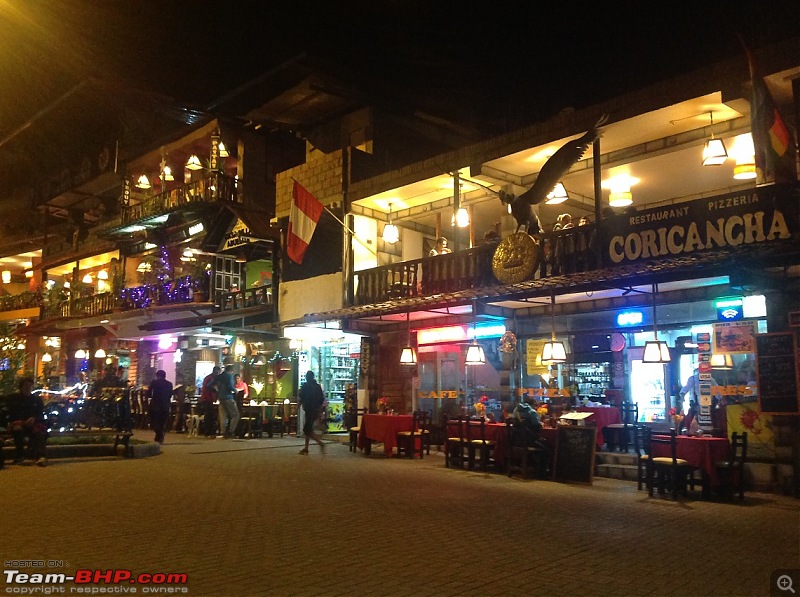 ▼ Image 84: A well-deserved dinner   The next morning was unpleasant - I was stiff everywhere and my knees were swollen and tender. Going for a bath required me to hobble down stairs slowly and despite the hearty breakfast it took me 30 minutes to gingerly walk down the 0.75 km to the centre in order to undertake my return hike to the Hydroelectrico. Timing was important - I wanted to reach Santa Maria by 1330 for the scheduled afternoon bus and assumed the return being more definitive would be faster. Unfortunately walking the railway tracks in my condition was arduous and painful and made up for the gain in time. The return journey was no less lonely though the noon sun made it brighter. The last 20 minutes tested my endurance and more than once I had to slide on my rear down the sloping paths due to the debilitating pain; looking back the hike was sheer will power since physically the exertion was too much. ▼ Images 85-92: Return hike to the Hydroelectrico   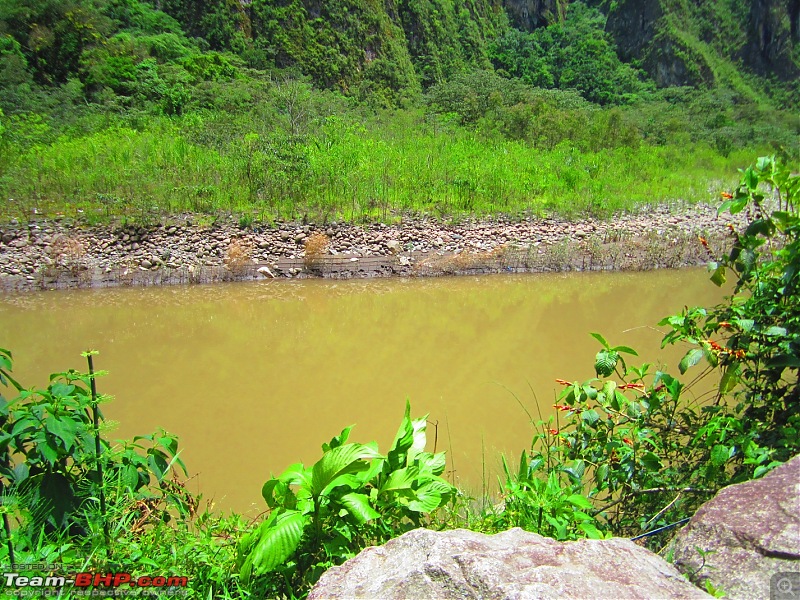  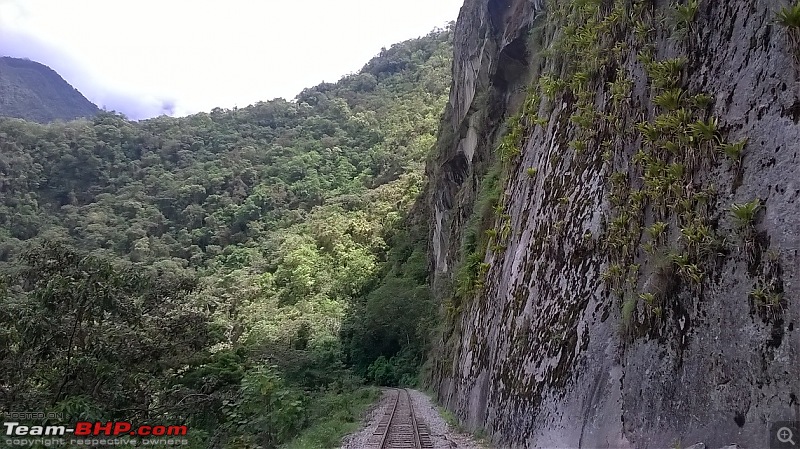    I finally reached the Hydroelectrico at a few minutes before 1300 only to realise I was in for a wait as the only collectivos present were pre-booked. I finally found one free but had to wait 35-40 minutes to get another six passengers (including a French woman who slyly tried to steal my front seat when I went away to buy some fruit). This collectivo was going all the way to Santa Maria so I would not have to change at Santa Teresa. The return journey was fast, bumpy and hot - punctuated by two breaks to buy delicious piña (pineapple) and refill our water bottles from roadside streams. ▼ Images 93-95: Return journey to Santa Maria    At 1615, about 5 km before Santa Maria we came across a stationary van - the driver was heading back to Cusco and since nearly everyone on board our vehicle were headed there we did some bargaining (S/35) and switched transport. The van picked up 2-3 more passengers on the long ride back, stopping thrice for toilet breaks, and once to buy some shawls made from the fibre of a variety of agave (called Cactus silk) and also once for a drug inspection by some well-armed police with sniffer dogs. We got into Cusco at 1900 and I was dropped off at the city centre by 1930. The place was full of people and after some directions I used public transportation to get back to my hosts, aided by some extremely generous and welcoming locals who went out of their way to guide me. My hosts were a bit worried at not receiving word from me and had kept a warm dinner waiting. ▼ Image 96: Peruvian police  ▼ Images 97-99: On the road to Cusco    ▼ Image 100: Cusco historical centre  10. Aftermath I spent the next day in Cusco recovering, drinking loads of coca-leaf tea and also shopping (it has some great options but Lima has more variety and possibly less touristy prices). My knees would continue to give me trouble for the next three weeks and it was not till March that I was fully healed (the cold weather in New York on my return did nothing to help). Later when I went to Ecuador this was a major reason I chose to rent a car as I had difficulty climbing or descending steps. (A narrative of that journey is here http://www.team-bhp.com/forum/travel...a-ecuador.html) I hope you enjoyed reading this very long and belated narrative. All I can say is: It was a fantastic experience, and notwithstanding the trouble I'm very happy I did it - in many ways the journey itself became an end and made the whole trip something of an adventure - with plenty of material for fireside stories (with and without embellishment). I’m happy to answer any questions in case anyone has plans to visit Machu Picchu. Peru is very tourist friendly, the people are extremely warm and welcoming and culturally similar to us. As an Indian citizen I aroused some curiosity wherever I went and none of the disdain that I've encountered in Europe (only once did I come across other Indian tourists). My Peruvian classmate informed me later that the government is likely to restrict access to Machu Picchu further in the years to come and there are plans to build glass walkways to stop tourists hurting the ruins; there may also be a reduction on the daily quota - so it’s a good idea to undertake a visit now. Last edited by Kumar R : 5th October 2017 at 07:15. |
| |  (61)
Thanks (61)
Thanks
 |
| The following 61 BHPians Thank Kumar R for this useful post: | 14000rpm, Acharya, agspins, ampere, Arun.K, BlackBeard, blahman, BopsKA12, bsdbsd, codelust, desiaztec, F2005, Gannu_1, gmhossain, govigov, grkonweb, GTO, HammerHead, hemanth.anand, hifisharu, IcarusMan, isandy, itwasntme, jaunthead, jayakumarkp, Keynote, Klub Class, knightrider_7, libranof1987, Lij, Lobogris, luvDriving, mallumowgli, Mgdoodler, mpksuhas, Nempuguru, Nonstop-driver, novice_alto, parsh, poised2drive, procrj, pulsar56, Rehaan, rk_sans, saargoga, Samba, satan's_valet, sbala, selfdrive, siddarthab, SourabhSuresh, sparky@home, spikester, Torino, trek, trichy, VaibhaoT, vb-saan, YanTra Makto, yogesh.8984, yosbert |
| | #10 |
| Team-BHP Support  | re: Machu Picchu, Peru - The Lesser Known Route Thread moved from the Assembly Line to the Travelogues Section. Thanks for sharing! |
| |  (2)
Thanks (2)
Thanks
 |
| The following 2 BHPians Thank Aditya for this useful post: | GTO, Kumar R |
| | #11 |
| Senior - BHPian Join Date: Oct 2010 Location: Bangalore
Posts: 1,813
Thanked: 5,864 Times
| Re: Machu Picchu, Peru - The Lesser Known Route Excellent!  I have heard of Machu picchu, from the Nat geo Series, Ancient Aliens & Eric Von Daniken's famous books. Now, we have a travelogue on the same!  May I ask, from where did you get the idea/inspiration to travel to Peru especially Machu Pichu? |
| |  (1)
Thanks (1)
Thanks
 |
| The following BHPian Thanks abhishek46 for this useful post: | Kumar R |
| |
| | #12 |
| Senior - BHPian Join Date: Feb 2005 Location: Melbourne
Posts: 4,376
Thanked: 5,105 Times
| Re: Machu Picchu, Peru - The Lesser Known Route Excellent mate! Have bookmarked this for my travels! |
| |  (1)
Thanks (1)
Thanks
 |
| The following BHPian Thanks extreme_torque for this useful post: | Kumar R |
| | #13 |
| Senior - BHPian | Re: Machu Picchu, Peru - The Lesser Known Route Stupendous travelogue man. Keep up doing such things and posting. Should be one of the few detailed travelogues on net on Machu Picchu. Quite an inspiration too, especially daredevilry to trek up and down those trails. Been doing treks intermittently in Western Ghats and can totally relate to my earliest severe experiences of knee and leg problems while trekking down the treacherous rocky routes, as you detailed out herewith and still do sometimes. It does need getting fit and into habit of doing these regularly if one is to be able to sustain such trails. Keep it up.  |
| |  (1)
Thanks (1)
Thanks
 |
| The following BHPian Thanks parsh for this useful post: | Kumar R |
| | #14 |
| Team-BHP Support  Join Date: Sep 2010 Location: All over!
Posts: 7,613
Thanked: 18,336 Times
| Re: Machu Picchu, Peru - The Lesser Known Route Terrific travelogue and pictures! The Machu Picchu trail trip is the "one that got away"; something I'd been eagerly looking forward to while in the US but couldn't happen because of my unplanned return. I hope I'm in NA soon so I can plan this; your TL only reignites the anticipation! Also, kudos for hiking all the way!  Machu Picchu is one of THE destinations for the adventure-inclined folks, esp if you're in NA. |
| |  (1)
Thanks (1)
Thanks
 |
| The following BHPian Thanks libranof1987 for this useful post: | Kumar R |
| | #15 |
| BHPian Join Date: May 2010 Location: Bangalore
Posts: 744
Thanked: 336 Times
| Re: Machu Picchu, Peru - The Lesser Known Route Amazing Travelogue. I have always wanted to visit Machu Picchu, since the time I read about it my school books. I enjoyed reading about your trip. Awesome job. |
| |  (1)
Thanks (1)
Thanks
 |
| The following BHPian Thanks Newpunter for this useful post: | Kumar R |
 |


